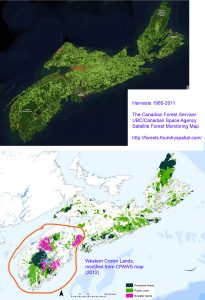How much wood? Plenty, but not on 50-year rotations!
 With promises of “the right balance” at some time in the future, clearcutting on Crown land continues unabated including cuts close to Protected Areas. The latest announcement cites plans for 48 parcels, 32 of which are 1-stage clearcuts, 15 are partial cuts. As usual, they include at least one cut on the border of a Protected Area, the one I viewed abutting Tidney River Wilderness Area in Queens Co. in southwest Nova Scotia. It is described as a Partial Harvest. (Most Partial Cuts in NS are shelterwood cuts which are considered 2-stage clearcuts by the feds; it’s possible this one is a selection cut – you have to request the PTA to find out).
With promises of “the right balance” at some time in the future, clearcutting on Crown land continues unabated including cuts close to Protected Areas. The latest announcement cites plans for 48 parcels, 32 of which are 1-stage clearcuts, 15 are partial cuts. As usual, they include at least one cut on the border of a Protected Area, the one I viewed abutting Tidney River Wilderness Area in Queens Co. in southwest Nova Scotia. It is described as a Partial Harvest. (Most Partial Cuts in NS are shelterwood cuts which are considered 2-stage clearcuts by the feds; it’s possible this one is a selection cut – you have to request the PTA to find out).
In my last post, I cited some wood volumes for Nova Scotia and other provinces, and wondered about the exceptionally low volumes of wood harvested from our Crown lands in 2015 (77 m3/ha compared to 123 m3/ha on Private lands in Nova Scotia and values for Crown lands in other provinces in the range 107-319 m3/ha, BC highest).

Panel shows areas of proposed harvests from the NS Harvest Plans Map Viewer, estimates of harvestable wood volumes from the NS Landscape Maps Viewer, and recent forest disturbances from Global Forest Watch.
Click on image for a larger version; keep clicking to get the largest one.
The estimated volumes of wood per hectare in the area of the western set (192-243 m3/ha) are much larger than those from the central/eastern set (43-67 m3/ha) which wasn’t quite what I expected. I had expected that there would be more land with higher volumes in western NS than central/eastern NS (where there has been more harvesting), but that the harvest on Crown land would be focussed on sites of roughly equivalent volumes at both western and central/eastern sites.
For reference, wood volumes reported for four old growth stands in Nova Scotia are in the range 269 to 563 m3/ha* We can grow big trees in Nova Scotia but not on 50 year rotations! *Selected Nova Scotia old-growth forests: Age, ecology, structure, scoring. Bruce Stewart et al.(2003). The Forestry Chronicle 79: 632-644. Old-growth reference ages calculated for the stands ranged from 164 to 214 years.
 I think it is noteworthy that (i) there are some pretty high volumes in the western set of proposed harvests, and (ii) the estimated volumes of wood in the central/eastern NS set of proposed harvests are so low you would wonder why we are harvesting them at all.
I think it is noteworthy that (i) there are some pretty high volumes in the western set of proposed harvests, and (ii) the estimated volumes of wood in the central/eastern NS set of proposed harvests are so low you would wonder why we are harvesting them at all.
What is it about NS forestry that makes it profitable to harvest such low volumes?
And what are such harvests (which may be 2nd or even 3rd generation clearcuts) doing to carbon and nutrient storage, long term sustainability of the wood supply and to biodiversity conservation?. Conversely, it seems pretty self evident why the WestFor group is so keen to harvest the Western Crown Lands.

Harvests 1985-2011 (above) from the Canadian Space Agency Satellite Forest Monitoring Map and delineation of Western Crown Lands below.
I wish I could be reassured by the reassuring statements and stats in the recently issued State of the Forest (2016) report, but I am not. For starters, the aggregation of stats on a province-wide basis including Protected Areas and other unharvested forest lands obscures the state of the working forests. There is no mention of the peer-reviewed paper by NSDNR soil scientist Kevin Keys et. al. (2016) that underscores the low nutrient/acidification stress on a large part of the Nova Scotian landscape, especially SW Nova Scotia, and that it is exacerbated by harvest removals and that “Based on comparisons with NBM-NS output, approximately 1/4 to 1/2 of the assessed plantation sites have non-sustainable MMAI yield expectations…” But I read this report with some bias, I suppose.
In the meantime, we await word on the much anticipated* Independent Review of Forestry that is supposed to provide a fresh, unbiased view of these issues…
* Deputy Minister Julie Towers on June 29: “[we are] scoping it out, drafting Terms of Reference and we are bringing forward the options so that we can very quickly, days to weeks at most be able to bring that out to the public.”
